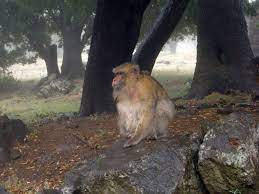This mountain range is long, and while it has some brief breaks, it continues for 1500 miles along the Nothern coast of Africa, from Morroco, through Algeria to Tunisia.

This area was once an incredibly wild area, and while only some of the former animals which lived here still survive, there is great efforts going into returning the missing ones back to the wild, either from captive descendants, or from closely related species.
Animals that still survive, include, Barbary Macaques (8000-10,000 but declining), Barbary Stag
Barbary leopards (in 1996 it was estimated that only 5 remained, it is unlikely that any are left), Barbary stag (not extinct, still found in quite a few places, but hard to get accurate estimates on numbers), Barbary sheep (listed as endangered, there are thought to be between 5000-10,000 remaining in the wild), Atlas mountain badger, Cuvier’s gazelle (thought to number no more than 2000 spread widely in the Atlas mountains) Northern bald Ibis (over 1000 live in zoos, but in the wild almost all of the 500 wild birds live in Morocco, at Souss-Massa National Park), Algerian nuthatch (thought to have a wild population of under 1000), dippers (the only species if Dipper in Africa) and Atlas mountain viper (this species is only near threatened, making it the safest species on this list).
There are a variety of species that are extinct:
- Barbary lions: (the north African lion was a popular species to hunt, there is thought to be around 100 in zoos around the world – probably not pure Barbary but as close as possible. There are vague plans to reintroduce them, but it remains to be seen if that can happen)
- Atlas bear: (last one reportedly shot in 1870, it does not appear that they did well in captivity, whether a closely related bear might fill the evolutionary niche is questionable)
- North African Elephant: closely related to the living African elephant species, it is therefore possible that a population could be re-established in this region. Proper genetic analysis is necessary, in order to work out which living species is the closes relation.
- Scimitar horned Oryx: It is thought that the numbers fell both because over-hunting and climate change making their hard life harder. There are 1800 left in the world but most of these are in captivity. A small population has been reintroduced in Chad, it should be possible to return them to the Atlas mountains without too much effort.
- Bubal Hartebeest: extinction date was officially declared in 1994, though it is thought to have been extinct in some regions since 1920, though it is thought the last Algerian specimen was killed between 1945 and 1954. There are a variety of living species which could fill in the ecological niche and behave in the same way (Liechtenstein or red hartebeest).











